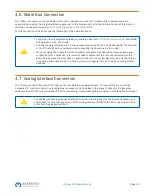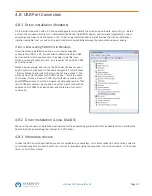
Page 25
mPower 300 Series (Rev G)
5.3 Alarm Conditions
This section only gives an overview about hardware alarms. What to do in case your system indicates
an alarm condition is described in section
As a basic principle, all alarm conditions are signalled visually (text + message in the display), audibly (if activated), and as
a readable status via the digital interface. With any alarm occurring, the DC output of the unit is switched off. In addition,
the alarms OT and OVP are reported as signals on the analog interface.
5.3.1 Available alarm signals
The equipment offers various signals for alarm conditions, however, not necassarily for all potentially dangerous
situations. The signals may be visual (on the display as text) acoustic (piezo buzzer) or electronic (pin/status output of an
analog interface). All alarms will cause the system to permanently or temporarily switch off the DC output.
The meaning of the signals is as follows:
Signal
OT
(OverTemperature)
Overheating of the unit
DC output will be switched off temporarily
Non-critical
Signal
OVP
(OverVoltage)
Overvoltage shutdown of the DC output due to high voltage entering the unit or generated
by the unit itself due to a defect or because the adjusted OVP threshold was lower than the
actual output voltage
Critical! The unit and/or the load could be damaged
Signal
OCP
(OverCurrent)
Shutdown of the DC output due to excess of the preset limit
Non-critical, protects the load from excessive current consumption
Signal
OPP
(OverPower)
Shutdown of the DC output due to excess of the preset limit
Non-critical, protects the load from excessive power consumption
Signal
PF
(Power Fail)
DC output shutdown due to AC undervoltage or defect of the AC input circuit
Critical on overvoltage! AC input circuit could be damaged
5.3.2 Power fail
Power Fail (PF) indicates an alarm condition which may have various causes:
•
AC input voltage too high (mains overvoltage) or too low (mains undervoltage, mains failure)
•
Defect in the input circuit (PFC)
Switching off the unit by the mains switch can not be distinguished from a mains blackout and thus
the unit will signal a PF alarm every time the unit is switched off. This can be ignored.
















































